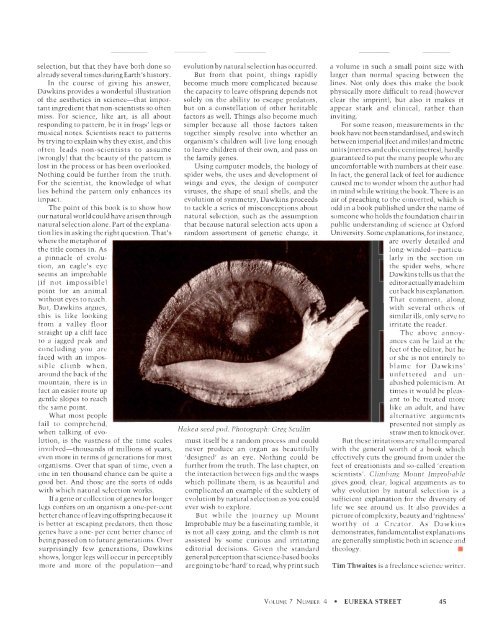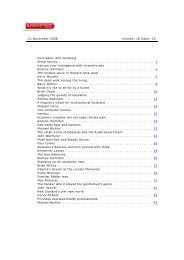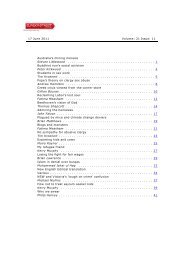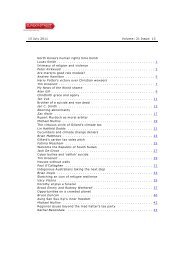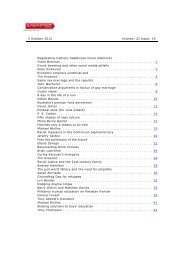n - Eureka Street
n - Eureka Street
n - Eureka Street
You also want an ePaper? Increase the reach of your titles
YUMPU automatically turns print PDFs into web optimized ePapers that Google loves.
selection, but that they have both done soalready several times during Earth's history.In the course of giving his answer,Dawkins provides a wonderful illustrationof the aesthetics in science-that importantingredient that non-scientists so oftenmiss. For science, like art, is all aboutresponding to pattern, be it in frogs' legs ormusical notes. Scientists react to patternsby trying to explain why they exist, and thisoften leads non-scientists to assume(wrongly) that the beauty of the pattern islost in the process or has been overlooked.Nothing could be further from the truth.For the scientist, the knowledge of whatlies behind the pattern only enhances itsimpact.The point of this book is to show howour natural world could have arisen throughnatural selection alone. Part of the explanationlies in asking the right question. That'swhere the metaphor ofthe title comes in. Asa pinnacle of evolution,an eagle's eyeseems an improbable(if not impossible)point for an animalwithout eyes to reach.But, Dawkins argues,this is like lookingfrom a valley floorstraight up a cliff faceto a jagged peak andconcluding you arefaced with an impossibleclimb when,around the back of themountain, there is infact an easier route upgentle slopes to reachthe same point.What most peoplefail to comprehend,when talking of evolution,is the vastness of the time scalesinvolved-thousands of millions of years,even more in terms of generations for mostorganisms. Over that span of time, even aone in ten thousand chance can be quite agood bet. And those are the sorts of oddswith which natural selection works.If a gene or collection of genes for longerlegs confers on an organism a one-per-centbetter chance of leaving offspring because itis better at escaping predators, then thosegenes have a one- per cent better chance ofbeing passed on to future generations. Oversurprisingly few generations, Dawkinsshows, longer legs will occur in perceptiblymore and more of the population- andevolution by natural selection has occurred.But from that point, things rapidlybecome much more complicated becausethe capacity to leave offspring depends notsolely on the ability to escape predators,but on a constellation of other heritablefactors as well. Things also become muchsimpler because all those factors takentogether simply resolve into whether anorganism's children will live long enoughto leave children of their own, and pass onthe family genes.Using computer models, the biology ofspider webs, the uses and development ofwings and eyes, the design of computerviruses, the shape of snail shells, and theevolution of symmetry, Dawkins proceedsto tackle a series of misconceptions aboutnatural selection, such as the assumptionthat because natural selection acts upon arandom assortment of genetic change, itHakea seed pod. Photograph: Greg Scullinmust itself be a random process and couldnever produce an organ as beautifully'designed' as an eye. Nothing could befurther from the truth. The last chapter, onthe interaction between figs and the waspswhich pollinate them, is as beautiful andcomplicated an example of the subtlety ofevolution by natural selection as you couldever wish to explore.But while the journey up MountImprobable may be a fascinating ramble, itis not all easy going, and the climb is notassisted by some curious and irritatingeditorial decisions. Given the standardgeneral perception that science-based booksare going to be 'hard' to read, why print sucha volume in such a small point size withlarger than normal spacing between thelines. Not only does this make the bookphysically more difficult to read (howeverclear the imprint), but also it makes itappear stark and clinical, rather thaninviting.For some reason, measurements in thebook have not been standardised, and switchbetween imperial (feet and miles) and metricunits (metres and cubic centimetres), hardlyguaranteed to put the many people who areuncomfortable with numbers at their ease.In fact, the general lack of feel for audiencecaused me to wonder whom the author hadin mind while writing the book. There is anair of preaching to the converted, which isodd in a book published under the name ofsomeone who holds the foundation chair inpublic understanding of science at OxfordUniversity. Some explanations, for instance,are overly detailed andlong-winded-particularlyin the section onthe spider webs, whereDawkins tells us that theeditor actually made himcut back his explanation.That comment, alongwith several others ofsimilar ilk, only serve toirritate the reader.The above annoyancescan be laid at thefeet of the editor, but heor she is not entirely toblame for Dawkins'unfettered and unabashedpolemicism. Attimes it would be pleasantto be treated morelike an adult, and havealternative argumentpresented not simply asstraw men to knock over.But these irritations are small comparedwith the general worth of a book whicheffectively cuts the ground from under thefeet of creationists and so-called 'creationscientists'. Climbing Mount Improbablegives good, clear, logical arguments as towhy evolution by natural selection is asufficient explanation for the diver ity oflife we see around us. It also provides apicture of complexity, beauty and 'rightness'worthy of a Creator. As Dawkinsdemonstrates, fundamentalist explanationsare generally simplistic both in science andtheology.•Tim Thwaites is a freelance science writer.V OLUME 7 NUMBER 4 • EUREKA STREET 45


